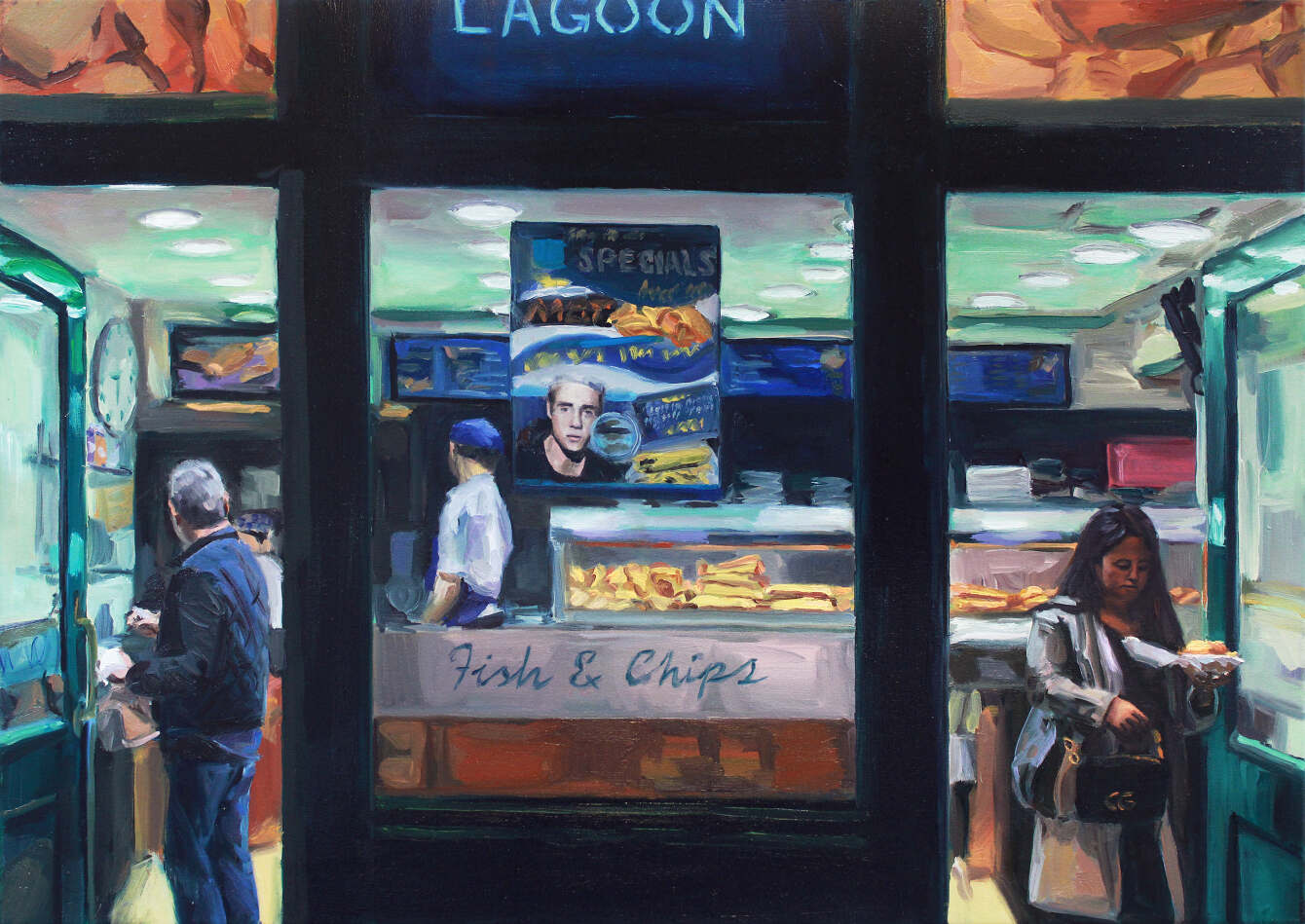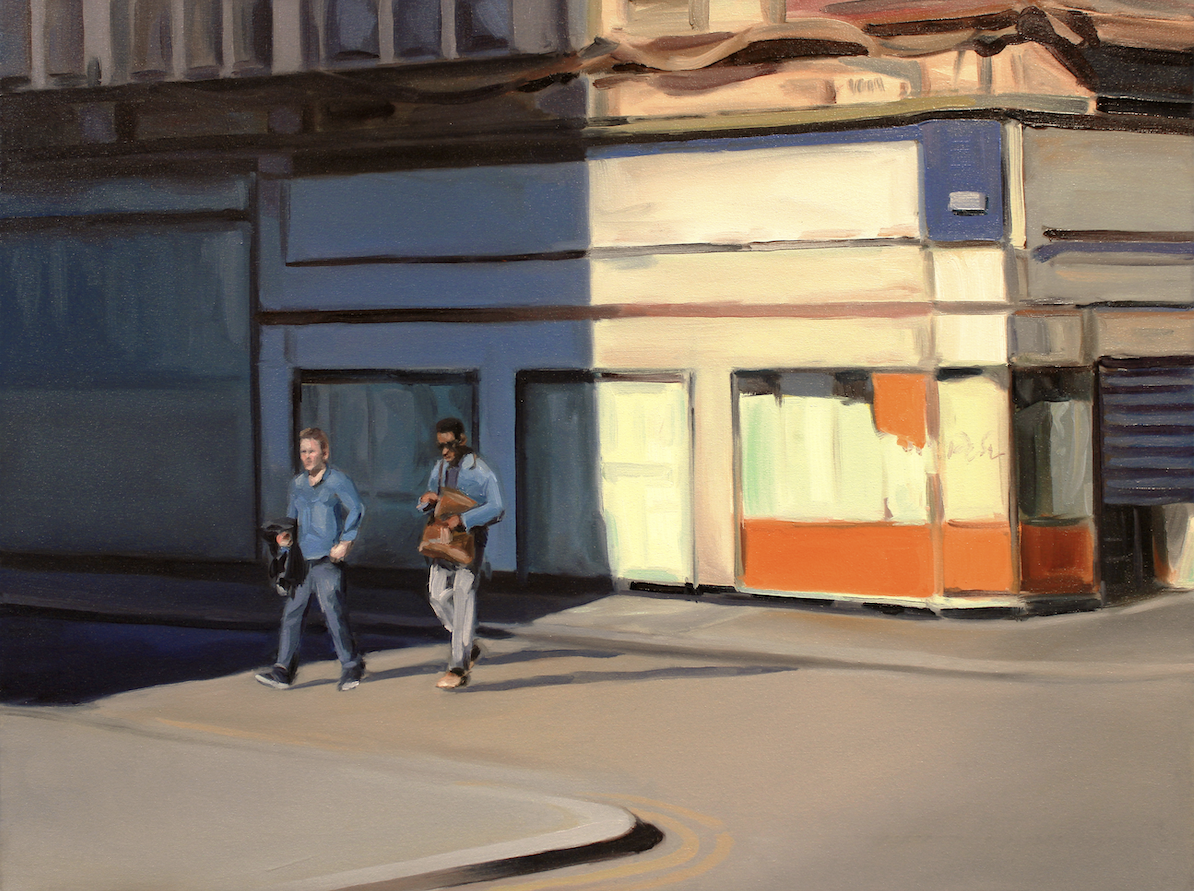We are thrilled to share an exclusive interview with London-based painter Thomas Cameron! In our discussion, the artist tells us about where he found his first source material for his paintings, the aspects of cinema that inspire him, and how the effects of the pandemic on his immediate surroundings has influenced his work.
Artist Statement:
My paintings stem from an interest in the scenes that often go overlooked due to their familiarity. I am drawn to fleeting moments which have an ambiguity and understated quality to them. I think of my paintings as stills from a film – small parts of a bigger story, often with a suggestion of narrative.

When did you start painting and when did you first consider yourself an artist?
I was always interested in art at school and I started to use oil paints whilst preparing my portfolio for admission to art school. At the time, I was working on a series of portraits, and these were the first paintings that I made. I was excited by the range of effects and depth of color I could get from oils, even with a limited palette.
I considered myself an artist probably after finishing my undergraduate degree. It was shortly after this that I got my first studio in Glasgow and started to exhibit more regularly. People began to take an interest in my work and connect with it, which encouraged me and gave me confidence in my practice.
What draws you to street scenes as your subject matter? Do you take snapshots as references, or do you perhaps sketch on location?
The idea of temporality and the everyday are the main areas of interest in my subjects. Within these there are a range of themes that I return to, which may include consumerism, urban living, liminal spaces, absurdity, isolation, and disconnectedness.
I’ve always been drawn to my immediate surroundings – seemingly simple things that are perhaps overlooked. My first paintings were from family photo albums. The snapshot quality of ordinary moments interested me, painting them on large scale in oils gave an element of grandeur to the mundane. The images I gather now also have this same ephemeral, candid nature that I was looking for when selecting found polaroid images.
I’ve also always had a strong interest in architecture and lighting. More recently, the sparsely populated urban environments that became dominant features of the lockdown in 2020, together with the decline of the high street, which I would walk through everyday in my commute to the studio, became strong influences on my work. I don’t generally sketch on location, instead using my camera to record precise and fleeting moments. I may draw or sketch from these if I feel it will aid the process of distilling an image, figuring out the composition, or more simply to slow down the process and consider what it is about the image that interests me.

Your paintings have a narrative quality about them that is almost cinematic. Are you inspired by film at all?
Film and narrative are important aspects to my practice. I use filmic imagery in my paintings to direct the sense of the mood. I am interested in a heightened and constructed realism, more akin to the way a filmmaker works. Ambiguity helps create an open narrative, inviting the viewer to ask what exactly we are meant to be looking at, and why?
Where did you study art? How did this experience affect how you approach painting?
I studied my BA at Dundee at Duncan of Jordanstone College of Art & Design and am currently studying for an MA at City and Guilds of London Art School. I also did an Erasmus in Germany at the Karlsruhe Academy of Fine Arts. I chose these schools based on their strong technical support and excellent workshop facilities. As a student, it’s important to be supported and feel comfortable taking risks in your work rather than feeling that you have to make work to fit a certain trend or tutor’s taste.
Where do you live in Scotland? How would you describe the art scene there?
I lived in Glasgow before moving to London. There is a great art scene there, I was lucky enough to be in a studio with a wide range of artists and different practices.

Who would you say are your biggest influences, whether they be an artist or not?
I am influenced by a wide range of sources, including TV shows, news articles, or a conversation with a friend. I am also heavily influenced by film and photography. Recently I’ve been really enjoying the films of Mike Leigh and Wong Kar Wai. Photographers I’ve been looking at recently include Wolfgang Tillmans and Philip-Lorca diCorcia, where the mundane assumes a theatricality. Painters include Walter Sickert, Hopper, and Manet.
How important is it to be flexible and adaptive as an artist? What advice would you give other artists on how to be flexible and fluid while not compromising your goals and/or creative vision?
It’s very important to be flexible and adaptive as an artist as there’s a lot that’s out of your control. Often artists will take up part-time work to supplement their practices, and studios are often shared spaces where conditions may not be ideal. There’s a lot of compromise involved, but limitations can also inspire creativity.

.jpg)
.jpg)

.jpg)












